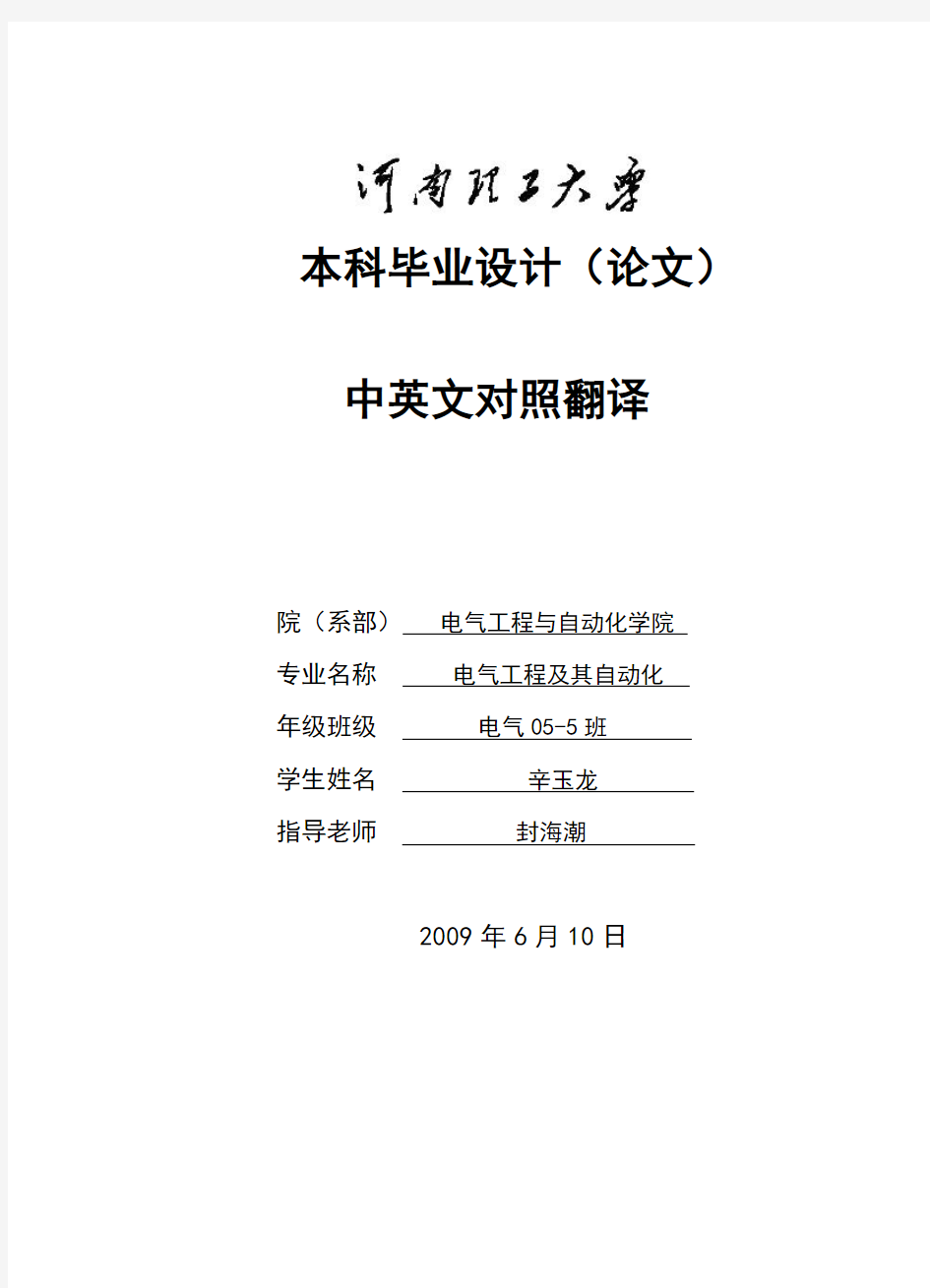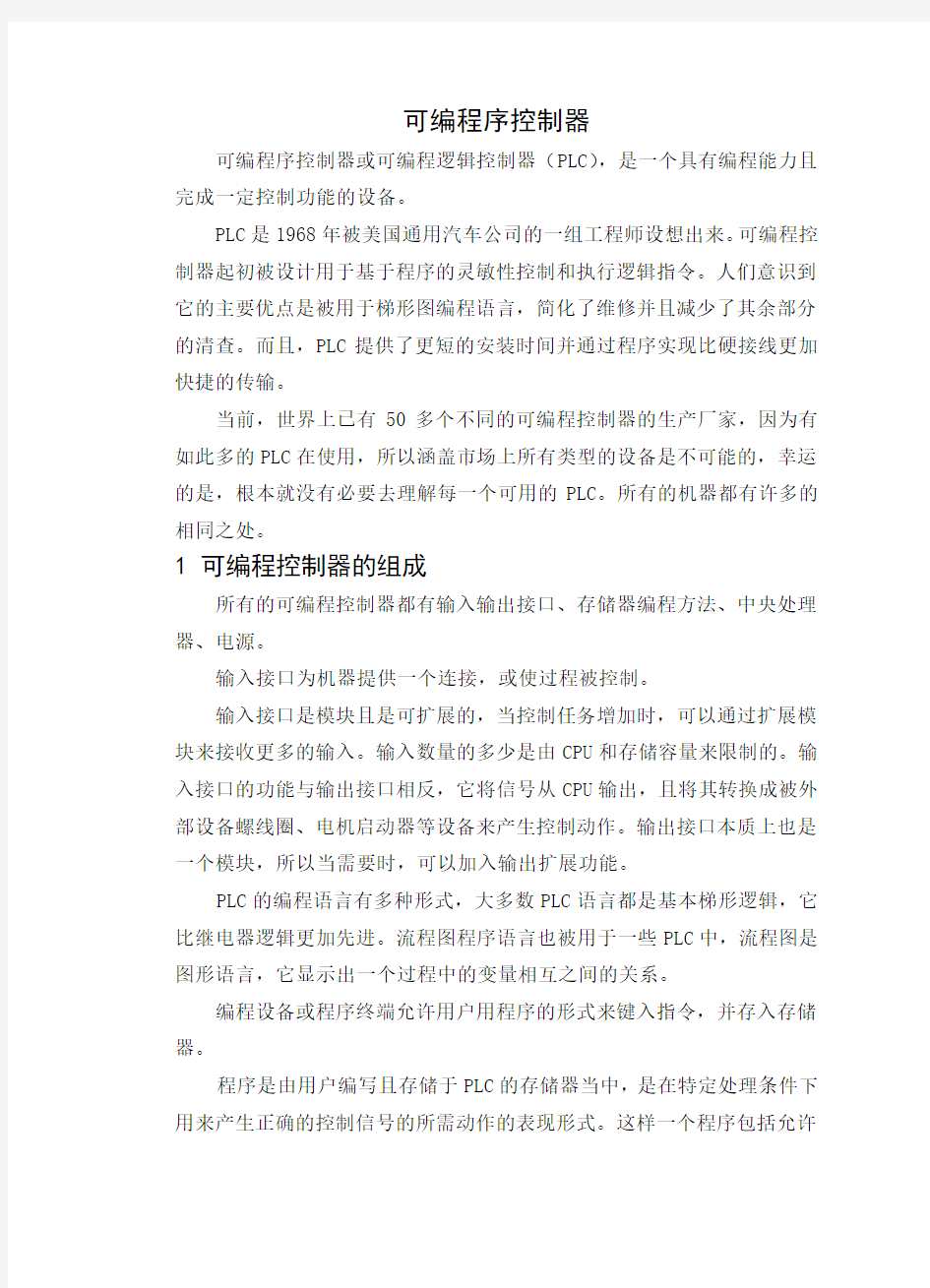毕业设计中英文翻译


本科毕业设计(论文)中英文对照翻译
院(系部)电气工程与自动化学院
专业名称电气工程及其自动化
年级班级电气05-5班
学生姓名辛玉龙
指导老师封海潮
2009年6月10日
可编程序控制器
可编程序控制器或可编程逻辑控制器(PLC),是一个具有编程能力且完成一定控制功能的设备。
PLC是1968年被美国通用汽车公司的一组工程师设想出来。可编程控制器起初被设计用于基于程序的灵敏性控制和执行逻辑指令。人们意识到它的主要优点是被用于梯形图编程语言,简化了维修并且减少了其余部分的清查。而且,PLC提供了更短的安装时间并通过程序实现比硬接线更加快捷的传输。
当前,世界上已有50多个不同的可编程控制器的生产厂家,因为有如此多的PLC在使用,所以涵盖市场上所有类型的设备是不可能的,幸运的是,根本就没有必要去理解每一个可用的PLC。所有的机器都有许多的相同之处。
1 可编程控制器的组成
所有的可编程控制器都有输入输出接口、存储器编程方法、中央处理器、电源。
输入接口为机器提供一个连接,或使过程被控制。
输入接口是模块且是可扩展的,当控制任务增加时,可以通过扩展模块来接收更多的输入。输入数量的多少是由CPU和存储容量来限制的。输入接口的功能与输出接口相反,它将信号从CPU输出,且将其转换成被外部设备螺线圈、电机启动器等设备来产生控制动作。输出接口本质上也是一个模块,所以当需要时,可以加入输出扩展功能。
PLC的编程语言有多种形式,大多数PLC语言都是基本梯形逻辑,它比继电器逻辑更加先进。流程图程序语言也被用于一些PLC中,流程图是图形语言,它显示出一个过程中的变量相互之间的关系。
编程设备或程序终端允许用户用程序的形式来键入指令,并存入存储器。
程序是由用户编写且存储于PLC的存储器当中,是在特定处理条件下用来产生正确的控制信号的所需动作的表现形式。这样一个程序包括允许
处理数据进入控制器的存储器中、处理阶段和将命令转换为外部动作阶段。
电源,像中央处理单元一样,电源必须能高质、清洁、可靠供电。PLC 系统的制造厂家采用专门的设计和生产方法对系统进行供电。虽然其它的系统将电源作为CPU的内部组成部分,便有些设计却允许对CPU进行外部供电。不管物理结构有何不同,电源的基本功能是相同的:那就是,提供一个持续的低压的直流电给电力系统,然后保证系统线电压的波动在正常范围内。
2 扫描功能
为了让PLC执行存储器中的程序,它必须能够识别在变化莫测的存储地址中都发了生了什么变化读取所在输入输出状态、检查应用程序指令和执行程序都涉及到了PLC的扫描功能。
CPU不断地与系统存储相互作用,去解释执行控制机器或过程的应用程序CPU读取程序所需时间的多少都存储在随机存储器的。执行控制功能更新所有输出就称为扫描时间。
扫描时间对于一个PLC来说是相当重要的因素,例如,如果一个输入信号在一次扫描仪中状态变化了2次,则PLC将不能识别该信号,这种病况就发生在输入信号变化快于扫描时间。如果扫描一个程序要用7ms的时间,一个输入触点每3ms就开关一次,则CPU就不知触点的状态在改变。在多数PLC的扫描时间都是以纠错、编译等不用的操作而调整。
每一个指令进入到程序中都需要一定的时间因为指令要被执行。所需时间的多少取决于指令。例如,CPU读取输出线圈的时间要比读取定时器累加器的时间要少。程序员的总长度本身也对扫描时间有影响。
扫描一个完整程序的时间的长在1ms到255ms扫描时间。当程序终端与CPU相连,扫描时间也就增加了,因为字将花更长的时间将I/O状态传送到显示屏上。
3 PLC 存储器
“存储器使用”涉及到存储每一类型指令所需的存储地址的个数。
每一个PLC生产厂家都用略微不同的方法去组织存储于PLC存储器中的信息。尽管每一个PLC在存储结构上都有相似性。例如RAM和ROM片。被存储信息的位地址和CPU读取这一数据的方法都非常地多变。
典型的PLC完整的处理存储被分为三个主要部分:数据表、用户程序和信息存储区。这些区存储着关于输入输出设备状态的信息。同时也存储着程序指令和消息,图2示出了典型PLC的标准存储布局。这三个区中的每一个都有能力处理大量的信息。存储器本身的划分是依据多二进制数或位,它有处理能力。
在任何I/O系统中都可行的是对输入输出指令编址的方法。可编程控制器的I/O被分为两类:一类为固定或不可改变的编址方案;别一类是灵活,可改变的。地址是在CPU中的控制程序到外部的传感器或传动装置的通路。PLC的设计决定于系统是否具有变址能力,或是严格地按照其编址操作。
I/O系统基本上包括2个部分:I/O支架、I/O模块,对大多数PLC来说一个模块被插入的地址被定为每个连接设备的地址,一个模块通常包括8个输入或输出,尽管16个输入输出也可以利用。一个I/O插槽或支架,通常可支持8或16个模块。
4 I/O系统
I/O系统提供硬接线元件与CPU的接口。输入接口允许在关的状态信息传送到CPU,同时也允许CPU通过输出接口与操作信号通信,在其控制下去操作设备。与其他微处理器一样,CPU也有和输入输出接口相连的时间和控制电路。在每个循环中输入都被定义为信号,检查它们的地址并不断更新。当这种相互改变发生时,被修改的输出寄存器内容在这些时间电路的控制下传送到输出接口
灵活和编址方案允许设计PLC系统并分配一些区或阶段,这种安装方案允许系统设计都建立控制逻辑软件,而需限制在遵循顺序的I/O,导致了随机编址的I/O系统。灵活I/O编址的缺点是在一个在的PLC系统中,这样的设计会使当诊断和纠正错误非常困难。
I/O地址或者是十进制或是八进制。十进制方法遵循顺序I/O分配。诸如,输入1到8是每一个模块,9到16上第二个模块,17到24是每三个等等,八进制系统基于8个数字,0到7,一个8点I/O模块使用8进制系统会用0~7作为每一个模块,10~17是第二个,20~27是第三个。
在灵活编址方案中,I/O通常被物理设定为一系统并列编址,它与I/O 支架上特殊的插槽一起,一些PLC系统使用紫外线擦除存储器保持I/O地址数据。地址通常都在初始系统配置中建立。而且是永久的,在不可变系统中,单个插槽和点地址一般取决于I/O支架连接在一起的顺序,在小型PLC机中系统包含一个支架连接在一起的顺序,在小型PLC机中,系统包含一个支架,因此,I/O地址被生产厂家固定。
5 PID 模块
比例—积分—微分模块被用来应用在过程控制中,其中,PID算法在涉及3种方式闭环反馈控制中比较常见。PID模块允许过程控制在CPU之外发生。这种安排可以让CPU免除复杂的计算,在PID模块中的微处理器处理数据和比较数据去置位,决定合适的输出信号。大多数PID模块每个模块有4个控制回路。状态和诊断指示器被提供允许简单的系统维护,一旦它被设定配置一个模块包括配置模拟信号的类型数字信号的类型和其他条件。
6 程序终端
可编程控制器给用户提供一个在CPU存储器中的进入和监视程序的方法进入PLC程序有2种基本方法。它可用程序终端或电脑软件进行在2种情况下,程序终端被连接到由处理上的连接器CPU。这种连接器为典型25-pin RS-232C系列通信接口,且与大多数的IBM类计算机相兼容。
程序终端是进入程序和PLC监控而大量使用的设备。
终端最受欢迎的一种类型是迷你编程器,也叫手持编程器,这种类型的编程终端是不贵且可携带的,这就意味着使用更小的PLC,这些设备是与手持计算机一般大小,通常有LED或点阵LCD显示。键盘包括数字键程序指令键和特殊功能键。
近几年,已经形成朝着使用基于个人电脑程序开发系统方向发展的趋势。手提电脑或笔记本电脑,微型计算机进行PLC编程起来越受欢迎。个人电脑也允许简化开发和更方便的PLC编程技术。
Programmable Controller
A programmable controller, or programmable logic controller (PLC), is a device which is capable of being programmed to perform a controlling function.
The PLC was first conceived by a group of engineers from the Hydromantic division of General Motors in 1968. Programmable controllers were originally designed to provide flexibility in control based on programming and executing logic instructions .Major advantage were realized by adopting the ladder diagram programming language ,simplifying maintenance ,and reducing the cost of spare parts inventories .Also ,PLCs allowed for shorter installation time and faster commissioning through programming rather than wiring.
There are presently over 50 different manufacturers of programmable controllers .Because there are so many different PLCs in use ,it is impossible to cover all the different types of equipment on the market .Fortunately ,it really isn’t necessary to understand every some of the common features of programmable controllers .
1.Programmable Controller Components
All programmable controllers have input and output interfaces, memory, a method of programming, a central processing unit (CPU), and a power supply.
The input interface provides a connection to the machine or process being controlled.
The input interface is modular and can be expanded by adding more modules to allow more inputs when the control task increases. The number of possible inputs is usually limited by the CPU and the size of memory. The output interface performs the opposite function of the input interface. It takes signals from the CPU and translates them into forms that are appropriate to
produce control actions by external devices such as solenoids, motor starters, and so on; The output interface is also modular in nature, so that additional output functions can be incorporated when required.
PLC programming languages have many forms. Most PLC languages are based on ladder logic, which is an advanced form of relay logic. Flowchart programming language is also-used with some PLCs. A flowchart is a pictorial language that shows the interconnections of variables within a process.
A programming device, or programming terminal, allows a user to enter instructions into memory in the form of a program.
A program that is written by a user and stored in a PLC’s memory is a representation of the actions required to produce the correct output control signals for a given process condition. Such a program includes sections that allow process data to be brought into the controller memory, sections that represent decision making, and sections that deal with converting a decision into physical output action.
Power Supply,As smart as the central processing unit is, it would be nothing without good, clean, reliable power. The manufacturer of the programmable controller system takes special design and manufacturing care with the system power supply. Some designs allow the power supply to be used external to the main CPU chassis, while others make it an integral part of the system chassis. In spite of the physical differences, the primary function remains the same: that is, to provide a consistent level of clean, low voltage direct current (DC) power to the system electronics, and protects the system from normal line voltage fluctuations.
2.PLC Scan Function
In order for a CPU to execute a program stored in memory, it must be able to “see” what is occurring in the various memory locations. The procedure of reading the status of all inputs and outputs, examining application program
instructions, and executing the control program is referred to as the scan function of a PLC.
The CPU is constantly interacting with system memory to interpret and execute the application program that controls the machine or process. The amount of time required for the CPU to read the program stored in RAM memory, execute the control program, and update all outputs is called the scan time.
Scan time is a very important factor in a PLC. For example, if an input signal changes states twice during one scan, the PLC will never be able to “see”the signal. This situation occurs if the change in input signal is faster than scan time. If it takes 7 ms for the CPU to scan a program, and an input contact is opening and closing every 3 ms, the CPU does not know that the contact is changing state. Most PLCs have a scan time which can be adjusted for different operations such as troubleshooting, or debugging.
Each instruction entered into a program requires a certain amount of time for the instruction to be executed. The amount of time required depends on the instruction. For example, it takes less time for a CPU to read status of an output coil than it does to read the accumulated value of a timer. The overall length of the program itself will also have an effect on scan time.
The length of time required to scan an entire program once varies between 1 m and 255 ms, depending on the manufacturer and model number of the machine being used. The amount of RAM memory allocated by a manufacturer will have an effect on total scan time as well. Typically, 2 ms is added for each 1 kilobyte of memory available. When a programming terminal is connected to CPU, scan time also increases because it takes longer to transmit the status of I/O to the CRT screen.
3.PLC Memory
The term memory utilization refers to the number of memory locations
required to store each type of instruction.
Each PLC manufacturer uses a slightly different method of organizing the information which is stored in the memory of the PLC. Although all PLCs have similarities in their memory structure, such as RAM and ROM chips, the locations where bits of information are stored and the method the CPU uses to read this data can vary quite substantially.
The entire processor memory of a typical PLC is divided into three major parts: data table, user program, and message storage area. These sections store information about the status of an input or output device and are also used to store program instructions and messages. Figures 2 show the standard memory layout for a typical PLC. Each of the three sections is capable of handling various amounts of information. The memory itself is divided according to how many binary digits, or bits, it is capable of handling.
4.I/O System
The I/O system provides an interface between the hard wired components in the field and the CPU. The input interface allows status information regarding processes to be communicated to the CPU and allows the CPU to communicate operating signals through the output interface to the process devices under its control. Like any other microprocessor, the CPU has timing and control lines that connect to input and output interfaces. While this interchange is taking place, the revised output register contents are transferred to the output interface circuits under the control of these timing lines.
The I/O system basically consists of two components: the I/O rack and the I/O module. For most PLCs, the location of where a module is inserted defines the address of each connected device. A module usually consists of either 8 inputs or outputs, although module is also available with 16 inputs or outputs. An I/O rack, or chassis, will generally hold either 8 or 16 modules.
An important consideration in any I/O system is the method of
addressing the input and output instructions. Programmable controller I/O is divided into two general classes: those with fixed or nonflexible addressing schemes and those with flexible, adaptable addressing schemes. Addressing is the way that the control program in the CPU relates to a particular real-world sensor or actuator. The design of a PLC determines whether or not the system is capable of being addressed flexibly, or is rigid in its addressing method.
Flexible addressing schemes allow PLC systems to be designed and installed in several sections, or stages. This installation scheme allows system designers to create control logic software without being constrained to follow a sequential I/O assignment, resulting in a randomly addressed I/O system. The disadvantage of flexible I/O addressing is that in large PLC systems such a design may make it difficult to diagnose and correct problems when they occur. This is particularly true when proper PLC I/O documentation is not provided.
I/O addressing is either in decimal or octal form. The decimal method follows a sequential assignment of I/O points, such as inputs 1 through 8 for the first module, 9 through 16 for the second module, 17 through 24 for the third, and so on. The octal numbering system is based on 8 digits, 0 through 7. An 8-point I/O module using the octal numbering system would have addresses 0 through 7 for the first module, 10 through 17 for the second, and 20 through 27 for the third module.
In flexible addressing schemes, I/O is often addressed by physically setting a series of dual inline package switches, associated with a particular slot in the I/O rack. Some PLC systems use EEPROM memory to hold I/O address data. Addressing is generally established during initial system configuration, and is considered to be permanent. In nonflexible system, individual slot and point addresses are normally determined by the sequence in which the I/O racks are connected together. In the case of some small PLCs, the system contains one rack and therefore has I/O addressing fixed by the manufacturer.
5. PID Module
The proportional-integral-derivative(PID)module is used in process control applications where PID algorithms are used in what is commonly referred to as three-mode closed-loop feedback control .A PID module allows process control to take place outside the CPU. This arrangement prevents the CPU from being burdened with complex calculations. The microprocessor in the PID module processes data and compares the data to set points provided by the CPU and determines the appropriate output signal. Most PID modules have at least four channels or loops of control per module. Status and diagnostic indicators are provided to allow easy maintenance of the system once it is installed. Configuring a PID module includes configuring the types of analog signals, types of digital signals, and other signal conditions.
5.Programming Terminals
A programming terminal provides the user with a method of entering and monitoring a program in the CPU’s memory. There are two basic methods of entering a program into a PLC. It can be done with either a dedicated programming terminal, or with a computer using PLC software. In both cases, the programming terminal is connected to the CPU via the connector on the processor. This connector is typically a 25-pin RS-232C serial communications port, which is compatible with most IBM-type computers.
A dedicated programming terminal is a device used exclusively for program entry and PLC monitoring.
One of the more popular types of dedicated terminals is the hand-held programmer. This type of programming terminal is an inexpensive and portable means of programming small PLCs. These devices are often the size of hand-held calculators and usually have LED or dot matrix LCD displays. The keyboard consists of numeric keys, programming instruction keys, and special function keys.
In recent years, a definite trend has been developing toward the use of personal computer-based program development systems. Laptop, or notebook, microcomputers are becoming increasingly popular for programming PLCs. Personal computers allow the development of simpler and more convenient PLC programming techniques.
